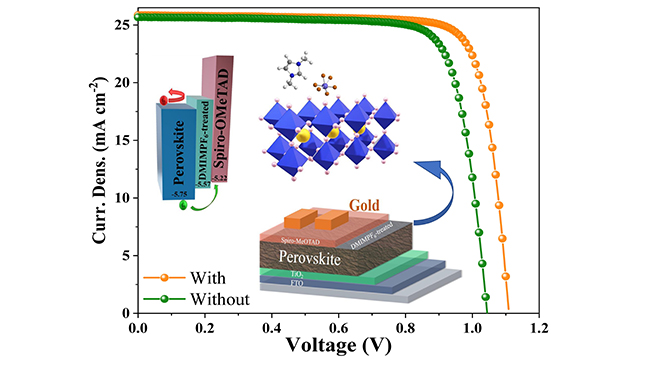The quality of perovskite film plays a key role in device performance. In general, the perovskite film is prepared by evaporating solvent from the precursor solution.
However, it yields defects at the grain boundaries and on the surface during the crystallization process. These defects cause perovskite decomposition and non-radiative recombination, causing negative impact on the device performance.
Surface passivation is considered as one of the most effective ways to reduce the number of defects due to its ease of application.
Recently, a research group led by Prof. LIU Shengzhong from the Dalian Institute of Chemical Physics (DICP) of the Chinese Academy of Sciences (CAS) reported high-efficiency perovskite solar cells with imidazolium-based ionic liquid for surface passivation and charge transport.
This results were published in Angewandte international Edition Chemie on November 6.

Efficient perovskite solar cells with imidazolium‐based ionic liquid for surface passivation and charge transport fabricated (Image by DUAN Lianjie)
"We used a novel 1,3-dimethyl-3-imidazolium hexafluorophosphate (DMIMPF6) ionic liquid (IL) to treat the perovskite surface and achieved a high power conversion efficiency of 23.25%," said Prof. LIU.
DMIMPF6 modulated the interfacial electronic properties of the perovskite, leading to a better-matched interfacial energy-level alignment between the perovskite and hole transport layer. DMIMPF6 IL had a strong passivation effect on the perovskite surface due to the formation of an electrostatic interaction between Pb2+ ions and DMIMPF6.
Moreover, since thin hydrophobic DMIMPF6 passivation layer blocked water permeation, DMIMPF6-treated devices showed remarkable long-term environmental stability.
This work offers an efficient way to reach future commercial production of high-performance perovskite photovoltaics.
This work was supported by National Natural Science Foundation of China, the Shaanxi Technical Innovation Guidance Project, S.L. acknowledges the Strategic Priority Research Program of Chinese Academy of Sciences, the National Key Research and Development Program of China, the National University Research Fund, the Innovative Research Team, the 111 Project. (Image by DUAN LianJie)